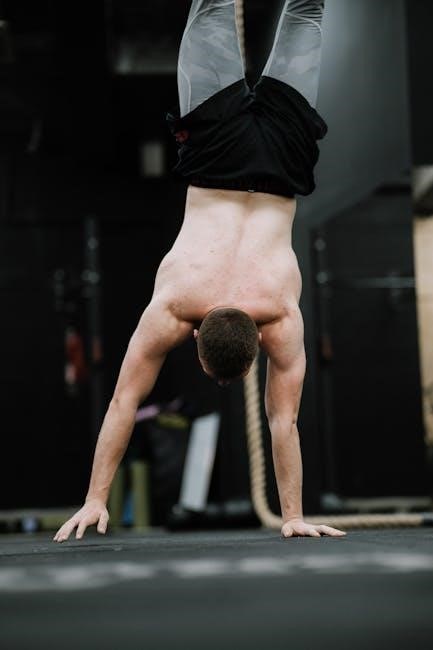Core stability exercises strengthen abdominal, hip, and spinal muscles, improving posture, balance, and reducing back pain․ They enhance overall physical performance and daily activity efficiency․

Understanding the Importance of Core Stability
Core stability refers to the ability of the trunk and pelvic muscles to maintain proper posture, alignment, and control during movement․ It serves as the foundation for all physical activities, ensuring efficient energy transfer and reducing the risk of injury․ Strong core stability enhances spinal support, promotes balanced muscle engagement, and improves overall athletic performance․ Weak core muscles can lead to poor posture, lower back pain, and decreased coordination․ By focusing on core stability exercises, individuals can strengthen their transverse abdominis and other deep stabilizers, creating a solid base for daily movements and sports-specific actions․ This foundational strength is essential for maintaining optimal physical function and preventing musculoskeletal imbalances․
Benefits of Core Stability Exercises
Core stability exercises offer numerous benefits, including improved posture, enhanced balance, and reduced lower back pain․ They strengthen the muscles around the spine, pelvis, and abdomen, providing better support and stability during movement․ Enhanced core stability boosts athletic performance by improving power transfer and coordination․ It also promotes better muscle engagement, reducing the risk of injuries and improving overall physical efficiency․ Additionally, these exercises can enhance respiratory function and promote proper alignment, leading to more efficient breathing and movement patterns․ By targeting deep stabilizers like the transverse abdominis, core stability exercises create a strong foundation for daily activities and sports, ensuring optimal physical function and reducing the likelihood of musculoskeletal imbalances․
Key Concepts for Effective Core Training
Effective core training relies on maintaining a neutral spine position to protect the lower back and ensure proper muscle engagement․ Activating the transverse abdominis muscle is crucial for stability, achieved by gently drawing the belly button toward the spine․ Proper breathing techniques, such as exhaling during efforts, enhance core engagement and prevent holding breath․ Starting with stable base positions, like tabletop or four-point kneeling, builds a strong foundation․ Progressing gradually from basic to advanced exercises ensures safety and effectiveness․ Incorporating both isometric holds and dynamic movements balances stability and mobility․ Focusing on controlled movements prevents compensatory patterns and promotes functional strength․ These principles ensure a well-rounded and injury-preventive core training program․

Essential Core Stability Exercises
Plank, bird dog, dead bug, and transverse abdominis activation are fundamental exercises that improve core stability, posture, and reduce lower back pain through targeted muscle engagement․
Plank Exercise
The plank exercise is a foundational core stability exercise that strengthens the abdominal, shoulder, and back muscles․ To perform it correctly, start in a prone position with your hands or forearms on the ground, shoulders aligned over your hands, and toes lifting your hips off the floor․ Engage your core by drawing your belly button toward your spine and maintain a neutral spine․ Hold this position without letting your hips sag or your back arch, ensuring deep breathing to maintain stability․ Aim to hold for 20-60 seconds, gradually increasing the duration as your strength improves․ Proper form is crucial to avoid strain and maximize the effectiveness of the exercise․ Regular planking helps improve posture, balance, and overall core endurance․
Bird Dog Exercise
The bird dog exercise is an effective core stability exercise that targets the deep abdominal muscles and promotes spinal stability․ To perform it, start on your hands and knees in a tabletop position․ Engage your core by drawing your belly button toward your spine and maintaining a neutral spine․ Slowly extend your right arm forward and your left leg backward, keeping them aligned with your torso․ Hold for a few seconds, then return to the starting position and repeat with the opposite arm and leg․ Focus on controlled movements and deep breathing to maintain stability․ This exercise improves posture, balance, and reduces the risk of lower back pain by strengthening the transverse abdominis muscle and enhancing spinal alignment․
Dead Bug Exercise
The dead bug exercise is a foundational core stability exercise that targets the transverse abdominis muscle, essential for spinal stability and posture․ Lie on your back with your arms extended overhead and legs lifted in a tabletop position, knees bent at 90 degrees․ Engage your core by drawing your belly button toward your spine to maintain a neutral pelvis․ Slowly lower your right arm and left leg toward the floor, keeping them straight, while maintaining control and breath․ Alternate sides with precise, controlled movements to avoid arching your back․ This exercise strengthens the deep abdominal muscles, enhances pelvic stability, and improves coordination․ It is particularly effective for reducing lower back pain and improving overall core engagement․
Transverse Abdominus Activation
Transverse abdominus activation is a fundamental exercise targeting the deepest abdominal muscle, essential for core stability and spinal support․ Lie on your back with knees bent and feet flat, engaging your core by drawing your belly button toward your spine to maintain a neutral pelvis․ Inhale deeply, then exhale fully, pulling your navel toward your spine while maintaining a relaxed breathing pattern․ Hold for 5-10 seconds, repeating for 8-12 repetitions․ This exercise strengthens the transverse abdominis, improves posture, and enhances spinal stability․ It is often used as a precursor to other core exercises to ensure proper engagement and reduce the risk of lower back pain during physical activities․
Pelvic Neutral and Core Engagement
Pelvic Neutral and Core Engagement is a foundational position for stability exercises, ensuring proper spinal alignment and core activation․ Lie on your back with knees bent, feet flat, and arms by your sides․ Engage your core by drawing your belly button toward your spine to maintain a neutral pelvis․ This position strengthens the deep abdominal muscles, improves posture, and reduces the risk of lower back pain․ Regular practice enhances overall core stability, making it easier to perform other exercises safely and effectively․ Maintaining Pelvic Neutral is essential for maximizing the benefits of core training and preventing injuries during physical activities․
Knee Tuck Exercise
The Knee Tuck Exercise targets the abdominal muscles while maintaining core stability․ Lie on an exercise ball with your lower back supported, feet wide apart on the floor for stability․ Place your hands on your thighs for support․ Crunch forward, sliding your fingers to your mid-thigh, then return to the starting position․ This exercise strengthens the abdominal muscles, improves posture, and enhances core engagement․ It is essential to maintain controlled movements and proper core activation to maximize effectiveness and prevent strain․ Regular practice helps improve overall core stability and supports other physical activities by strengthening the abdominal muscles․
Four-Point Kneeling Exercises
Four-Point Kneeling Exercises are excellent for improving core stability and strength․ Start on your hands and knees, ensuring your shoulders are over your hands and hips over your knees․ Engage your core by drawing your belly button toward your spine to maintain a neutral spine position․ Hold this stable position for 5-10 breaths, focusing on maintaining control․ Progress by extending one arm or leg while keeping the body steady, ensuring not to let the pelvis or shoulders shift․ This exercise enhances spinal stability, core engagement, and overall postural awareness․ It is ideal for building a strong foundation for more advanced movements and improving coordination․ Regular practice strengthens the core muscles and promotes better balance in daily activities and sports performance․

Table Top Base Level Exercise
The Table Top Base Level Exercise is a foundational core stability exercise․ Lie on your back with knees bent, feet flat on the floor, and arms by your sides․ Engage your core by drawing your belly button toward your spine to maintain pelvic neutrality․ Hold this position for 5-10 breaths, ensuring your lower back remains in contact with the floor․ Progress by extending one leg while keeping the core stable, then return to the starting position․ This exercise strengthens the transverse abdominis muscle, improves spinal stability, and enhances overall core awareness․ It is an excellent starting point for building core strength and preparing for more advanced exercises․
Isometric Oblique Stabilization
Isometric Oblique Stabilization is an effective exercise for strengthening the oblique muscles while maintaining core stability․ Lie on your back with knees bent and feet flat on the floor․ Engage your core by drawing your belly button toward your spine to maintain pelvic neutrality․ Place one hand on the outside of the opposite knee and gently resist the knee with your hand while keeping your spine stable․ Hold for 5-10 seconds, breathing naturally, then switch sides․ This exercise targets the obliques, improving spinal stability and core strength without spinal movement․ It is ideal for enhancing rotational stability and preventing lateral trunk instability during physical activities․ Regular practice helps build a stronger, more resilient core․
Abdominal Crunch on an Exercise Ball
The Abdominal Crunch on an Exercise Ball is an advanced core exercise that targets the rectus abdominis and obliques․ Sit on a stability ball with your lower back supported, feet flat on the floor, and knees bent at 90 degrees․ Engage your core by drawing your belly button toward your spine to maintain a neutral pelvis․ Place your hands behind your head for support, but avoid pulling on your neck․ Slowly lift your torso upward, curling toward the ceiling while keeping the ball stable․ Hold for 1-2 seconds at the top, then lower back down with control․ Perform 12-15 repetitions for 2-3 sets․ This exercise enhances posture, reduces back pain, and improves athletic performance by strengthening the abdominal muscles; Proper form is essential to avoid injury and maximize effectiveness․

Creating a Core Stability Workout Plan
A well-structured core stability workout plan includes setting clear goals, warm-up routines, progressive exercises, breathing techniques, maintaining neutral spine, and repetition guidelines to ensure effectiveness and safety․
Setting Goals for Core Stability Training
Setting clear goals is essential for effective core stability training․ Start by assessing your current fitness level and defining objectives, such as improving posture, enhancing athletic performance, or preventing injuries․ Tailor your goals to specific needs, like rehabilitation or overall fitness․ For example, if you’re rehabilitating a lower back injury, focus on stabilizing exercises to strengthen spinal muscles․ For athletes, aim to improve balance and power․ Create a balanced plan that includes progressive exercises, proper breathing techniques, and maintaining a neutral spine․ Regularly monitor progress and adjust goals as you achieve milestones․ This structured approach ensures a safe and effective core stability program․
Warm-Up Routine for Core Exercises
A proper warm-up is crucial before starting core stability exercises․ Begin with 5-10 minutes of light cardio, such as brisk walking or cycling, to increase blood flow and prepare muscles․ Follow with dynamic stretches targeting the major muscle groups, including hamstrings, hip flexors, and lower back․ Incorporate gentle movements like pelvic tilts and cat-cow stretches to improve spinal mobility․ Finish with activation exercises like deep breathing and Transverse Abdominus contractions to engage the core․ This routine ensures optimal preparation, reduces injury risk, and enhances exercise effectiveness․ Keep movements controlled and avoid overexertion․ A well-structured warm-up sets the foundation for a safe and productive core training session․
Progressing Through Exercise Levels
Progressing through core stability exercise levels ensures continuous improvement and prevents plateaus․ Begin with foundational exercises like Pelvic Neutral and Transverse Abdominus Activation to build awareness and control․ Gradually introduce exercises requiring greater stability, such as the Plank or Bird Dog, as strength and coordination improve․ Intermediate levels incorporate dynamic movements, like Dead Bugs or Knee Tucks, to challenge both strength and mobility․ Advanced phases introduce unsupported exercises, weights, or functional movements, such as Stability Ball Exercises or Limb Movements, to enhance real-world application․ Always master one level before advancing, ensuring proper form and engagement to avoid injury․ Progression should be tailored to individual ability and goals, with a focus on maintaining neutral spine and core engagement throughout․
Incorporating Breathing Techniques
Proper breathing is essential for effective core stability exercises․ Deep, controlled breaths help maintain spinal stability and enhance muscle activation․ During exercises like Plank or Dead Bug, exhale during the effort phase to engage the transverse abdominis, drawing the belly button toward the spine․ Inhale during the relaxation phase to replenish oxygen and maintain posture․ Avoid holding breath, as it can increase intra-abdominal pressure and reduce exercise effectiveness․ Coordinate breathing with movement to optimize core engagement and prevent compensatory patterns․ Practice diaphragmatic breathing to ensure a natural rhythm, promoting relaxation and focus․ Proper breathing techniques not only improve exercise performance but also contribute to overall core stability and muscle efficiency․

Maintaining Neutral Spine Position
Maintaining Neutral Spine Position
Maintaining a neutral spine position is crucial during core stability exercises to prevent injury and ensure effective muscle activation․ A neutral spine refers to the natural alignment of the spine, with a slight inward curve in the lower back and an outward curve in the upper back․ To achieve this, engage your core muscles by drawing your belly button toward your spine while avoiding excessive arching or flattening of the back․ Practice this position in exercises like Plank or Bird Dog by focusing on subtle core engagement without forcing the spine into an unnatural position․ Regular practice improves spinal awareness and promotes proper posture during workouts․

Repetition and Set Guidelines
Repetition and set guidelines are essential for optimizing core stability exercises․ Typically, 2-3 sets of 8-12 repetitions are recommended for strength and stability․ For endurance, higher repetitions (12-15) with fewer sets can be effective․ Progress gradually, increasing reps or sets as strength improves․ Consistency is key; aim for 2-3 sessions per week․ Rest periods of 60-90 seconds between sets allow proper recovery․ Focus on controlled movements and proper form to maximize benefits and prevent injury․ Adjust repetitions based on individual fitness levels and goals, ensuring exercises remain challenging yet manageable․ Regular progression helps maintain engagement and avoids plateaus in core stability training․
Rest and Recovery Between Sets
Rest and recovery between sets are crucial for effective core stability training․ Typically, 60-90 seconds of rest is recommended to allow muscles to recover and rebuild strength․ During this time, focus on deep breathing to promote relaxation and maintain proper spinal alignment․ Avoid rushing through sets, as adequate rest prevents fatigue and maintains form․ Proper recovery ensures that each exercise is performed with maximum efficiency and control․ Consistent rest periods also help in progressing through higher intensities safely․ By incorporating appropriate rest, individuals can optimize their core stability workouts, enhancing both performance and overall muscle endurance over time․
Advanced Core Stability Techniques
Advanced core stability techniques involve dynamic movements, unsupported exercises, and stability ball training, enhancing strength and functional movement for improved balance and coordination in athletes and serious trainers․
Unsupported Exercises with Weights
Unsupported exercises with weights challenge the core by requiring stabilization without external support․ These advanced techniques enhance strength and stability by engaging the transverse abdominis and obliques․ For example, overhead presses or weighted bird dog exercises demand precise core activation to maintain posture and control․ They improve functional movement patterns and athletic performance by simulating real-world challenges․ Start with lighter weights to focus on form and progression․ Over time, increasing the load builds resilience and power․ These exercises are ideal for those seeking to advance their core training, offering a dynamic way to improve balance, coordination, and overall physical stability․ Proper breathing and spinal alignment are crucial to maximize benefits and prevent injury․
Dynamic Core Movements
Dynamic core movements involve active, flowing exercises that challenge stability while introducing motion․ These exercises, such as bird dog or dead bug variations, require continuous engagement of the transverse abdominis and obliques to maintain control․ By incorporating movement, they enhance neuromuscular coordination, balance, and functional strength․ Dynamic movements mimic real-life actions, improving posture and reducing injury risk․ Start with controlled ranges of motion and gradually increase intensity․ Proper breathing and spinal alignment are essential to maximize effectiveness․ These exercises are ideal for advancing core stability while promoting muscle endurance and flexibility․ They bridge the gap between static holds and complex, dynamic movements, making them a valuable addition to any core training program․
Stability Ball Exercises
Stability ball exercises, also known as Swiss ball exercises, add an extra challenge to core training by introducing instability․ By performing movements like crunches, knee tucks, or planks on the ball, the core muscles must work harder to maintain balance․ These exercises engage the deep stabilizers, such as the transverse abdominis, while improving posture and overall coordination․ The unstable surface of the ball forces continuous engagement, enhancing muscle endurance and strength․ Stability ball exercises are versatile and can be adapted to different fitness levels, making them a popular choice for both beginners and advanced individuals․ They are particularly effective for improving dynamic core stability and functional movement patterns, while also enhancing balance and posture․ Regular use of the stability ball can lead to noticeable improvements in core strength and overall physical performance․
Core Stabilization with Limb Movements
Core stabilization with limb movements involves engaging the core while moving the arms or legs to challenge stability and strength; These exercises, such as the bird dog or dead bug, require maintaining a neutral spine and activating the transverse abdominis muscle․ By adding limb movements, the core must work dynamically to prevent excessive motion, enhancing functional strength and coordination․ This approach improves posture, reduces injury risk, and boosts athletic performance․ Limb movements can be progressed by increasing range or speed, making these exercises versatile for different fitness levels․ Regular practice enhances the ability to maintain stability during everyday activities or sports, promoting overall core resilience and efficiency․

Incorporating Pilates and Functional Training
Incorporating Pilates and functional training into core stability exercises enhances strength, flexibility, and coordination․ Pilates focuses on controlled movements, engaging the core to improve posture and reduce injury risk․ Exercises like the Hundred, Plank, and Single-Leg Stretch target deep abdominal muscles․ Functional training mimics daily activities, such as squats or lunges, to build practical stability․ These methods promote dynamic engagement of the core, improving balance and overall athletic performance․ By integrating Pilates and functional training, individuals can achieve a well-rounded core stability program that supports both rehabilitation and advanced fitness goals, ensuring long-term strength and resilience․ These approaches are highly adaptable, catering to various fitness levels and specific needs․ Regular practice enhances coordination, muscle memory, and functional movement patterns, making daily activities and sports more efficient and injury-free․

Core Stability for Specific Needs

Core stability exercises are tailored for specific needs, such as seniors, athletes, and lower back pain rehabilitation, promoting improved posture and functional strength effectively․
Core Exercises for Seniors
Core exercises for seniors are designed to enhance strength, balance, and posture while minimizing strain on the body․ Gentle movements like seated marching, wall push-ups, and bridging are ideal․ These exercises focus on improving stability and reducing the risk of falls․ Breathing techniques and Pilates-inspired movements are often incorporated to promote relaxation and flexibility․ Seniors can benefit from modified versions of core exercises that cater to their mobility levels․ Regular practice helps maintain independence and improves overall quality of life․ Professional guidance is recommended to ensure safety and effectiveness, especially for those with physical limitations or chronic conditions․
Core Stability for Athletes
Core stability is crucial for athletes, enhancing performance and reducing injury risk․ Exercises like planks, dead bugs, and stability ball workouts improve balance and coordination․ Dynamic movements and functional training strengthen the connection between core muscles and limbs, boosting power and endurance․ Athletes benefit from advanced techniques such as unsupported exercises with weights and limb movements, which simulate sports-specific actions․ Incorporating Pilates and mobility drills further enhances flexibility and control․ A strong core improves posture, stability, and overall athletic efficiency, making it a foundational element of any training program․ Regular core practice helps athletes maintain peak performance and adapt to the demands of their sport․
Exercises for Lower Back Pain Rehabilitation
Core stability exercises are essential for lower back pain rehabilitation, focusing on strengthening abdominal and spinal muscles to improve spine stability․ Key exercises include transverse abdominus activation, pelvic neutral, and bird dog․ These movements help restore proper posture and reduce pain․ Gentle progressions, such as tabletop base exercises and four-point kneeling, enhance core engagement without strain․ Breathing techniques are emphasized to maintain a neutral spine and avoid muscle tension․ Regular practice of these exercises can alleviate lower back pain by improving muscle balance and reducing mechanical stress on the spine․ They are often recommended in rehabilitation programs to promote long-term back health and prevent recurrence of pain․
Core Training for Improved Posture
Core training plays a vital role in improving posture by strengthening the muscles that support the spine․ Weak core muscles often lead to poor posture, such as slouching or an arched lower back․ Exercises like the bird dog and pelvic neutral help activate the transverse abdominis and multifidus muscles, which are essential for spinal stability․ Strengthening these muscles promotes proper alignment of the shoulders, hips, and pelvis, reducing strain on the body․ Regular practice of core exercises can help maintain a neutral spine and prevent postural imbalances, leading to better overall posture and reduced risk of back pain․
Preventing Injuries and Enhancing Performance
Core stability exercises reduce injury risk by strengthening spinal and pelvic muscles, improving balance, and enhancing athletic performance through better coordination and power transfer․
Role of Core Stability in Injury Prevention
Core stability plays a crucial role in injury prevention by strengthening the muscles that support the spine, pelvis, and kinetic chain․ A strong core enhances posture, reduces spinal strain, and improves balance, all of which contribute to lowering the risk of injuries during physical activities․ Weak core muscles often lead to poor movement patterns, increasing the likelihood of strain or damage to the lower back, hips, and other joints․ By engaging in core stability exercises, individuals can improve their body’s ability to maintain proper alignment and distribute force evenly, reducing the stress on vulnerable areas․ This is particularly beneficial for athletes and individuals with active lifestyles, as it helps maintain optimal physical function and minimizes the risk of overuse or acute injuries․
Enhancing Athletic Performance with Core Training
Core stability exercises are essential for enhancing athletic performance by improving strength, power, and endurance․ A strong core provides a stable base for generating force, enabling more efficient and powerful movements․ It enhances balance, coordination, and overall physical efficiency, reducing energy waste during activities․ For athletes, core training improves posture, reduces fatigue, and minimizes the risk of injury․ Specific exercises like planks, bird dogs, and dynamic movements target the muscles around the spine, pelvis, and hips, which are crucial for explosive actions in sports․ By incorporating core training into their regimen, athletes can achieve better overall performance, maintain proper form, and gain a competitive edge in their respective sports․
Core Stability for Better Balance and Coordination
Core stability is fundamental for improving balance and coordination, as it enhances the body’s ability to maintain control during dynamic movements․ A strong core provides a stable foundation, reducing wobbling and improving posture․ Exercises like single-leg stands, bird dogs, and wobble board training challenge the core muscles, strengthening the connection between the brain, muscles, and joints․ This enhanced stability boosts coordination, allowing for more precise and efficient movements․ Whether for athletes or everyday activities, core stability enhances overall physical efficiency and reduces the risk of falls or injuries, making it an essential component of any fitness or rehabilitation program․
Core stability exercises are essential for enhancing strength, posture, and overall physical performance․ Download the Core Stability Exercises PDF for detailed routines and expert guidance to improve balance, coordination, and injury prevention․
Core stability exercises are fundamental for improving posture, balance, and overall physical performance․ They target abdominal, hip, and spinal muscles, enhancing strength and reducing injury risk․ Key exercises include planks, bird dogs, and dead bugs, which promote neutral spine alignment and proper breathing techniques․ Progression from basic to advanced levels ensures continuous improvement․ Incorporating Pilates and functional training adds variety and effectiveness․ These exercises are beneficial for seniors, athletes, and individuals with lower back pain, aiding in rehabilitation and posture correction․ A Core Stability Exercises PDF provides comprehensive guides, ensuring safe and structured routines for all fitness levels․
Downloading Core Stability Exercises PDF
Accessing a Core Stability Exercises PDF is an excellent way to obtain a comprehensive guide to improving your core strength and stability․ These downloadable resources often include detailed instructions, illustrations, and progressive routines tailored for various fitness levels․ Many physiotherapy websites and fitness platforms offer free or premium PDF downloads, ensuring you can follow structured programs at home․ The PDF typically covers essential exercises like planks, bird dogs, and transverse abdominis activations, along with tips for maintaining proper form and breathing techniques․ Downloading this resource provides convenience, portability, and a clear roadmap to enhance your core stability and overall physical performance․




About the author